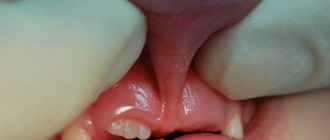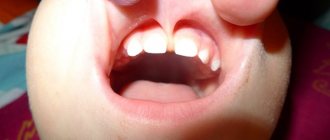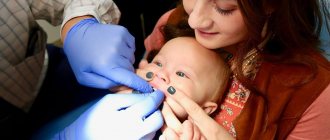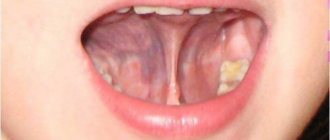Symptoms and clinical picture of a short frenulum of the tongue in a child
Signs of a short frenulum may not be noticed by inexperienced parents or those who do not know about this pathology; usually the problem is identified by nurses and doctors in the maternity hospital. The characteristic manifestations of ankyloglossia are as follows:
- when trying to stick out the tongue, it takes an arched position;
- when the tongue is raised, the frenulum is tensioned, as a result of which the body of the organ takes on the appearance of a heart;
- the tongue is fixed at the bottom of the oral cavity and cannot fully “come out” out.
Since the symptoms of a short frenulum of the tongue in a child are not obvious, you should pay attention to the following nuances.
In the first year of life, problems arise when breastfeeding. The child cannot properly grasp the nipple with his lips, squeezes it excessively with his gums, or bites it. This leads to malnutrition, hence anxiety and frequent crying.
Later, irregular teething may occur, with displacement or initial malocclusion.
At the time of speech development, difficulties are also noted; the child has difficulty pronouncing hissing and upper articulation sounds, and may burr.
At a later age, frequent and very painful tears of the shortened ligament are added to the described troubles.
Short frenulum of the tongue
The frenulum of the tongue is a special fold of the oral mucosa, which stretches in the form of an arc from approximately the middle of the tongue to the base of the gums in the area of the lower front incisors. The frenulum of the tongue serves as an additional means of attaching the tongue to the floor of the mouth. Shortening of the frenulum of the tongue is an anomaly in which the upper end of the frenulum is not in the middle of the tongue, but much closer to the tip or even at the very tip of the tongue. It can be complete when the tongue is completely attached to the floor of the mouth and partial when the frenulum is shortened.
A short frenulum of the tongue in medical terminology is called Ankyloglossia.
Sign of a short frenulum of the tongue:
- Heart-shaped tongue in an elevated position
- Inability to extend the tongue so that the tip is sharp
- The tongue curls down when it moves forward
- Difficulty in the act of swallowing, the chewing process (in children, impaired sucking function)
- Impaired pronunciation of sounds and changes in diction
- Bite pathology
- Periodontal diseases
Determining on your own whether you have a tongue tie or not can be difficult because... with a slight shortening of the frenulum, the symptoms are “erased.” Therefore, it is better to undergo an examination by a dentist or orthodontist in our dental center and make sure that everything is in order.
Indications for lingual frenuloplasty:
A short frenulum of the tongue in infancy leads to various disorders: impaired breastfeeding, poor weight gain, early cessation of breastfeeding and, as a consequence, significant retardation in growth and development. This pathology in infants can be detected in the maternity hospital by a pediatric neonatologist. In infants, the lingual frenulum, which is an avascular and muscleless cord, is cut with scissors without suturing, followed by placing the child to the chest for better wound healing.
After simply cutting the frenulum of the tongue with scissors, a rough scar may form, which will also require plastic surgery of the frenulum of the tongue when the child grows up.
In older children, the structure of the frenulum changes (it becomes more dense, vessels appear in it), so they are indicated for surgical intervention - plastic surgery of the frenulum of the tongue.
In preschool children, frenulum pathology is usually detected by a speech therapist. This is due to the organic type of dyslalia, in which the child does not pronounce palatal, hissing and whistling sounds due to limited tongue mobility. A speech therapy examination reveals that the child cannot stick out his tongue or reach the upper incisors with the tip of his tongue. It should be understood that after plastic surgery of the frenulum of the tongue, independent normalization of speech does not occur, therefore, children with speech pathology require a course of corrective speech therapy classes.
Orthodontic indications for plastic surgery of the lingual frenulum include restraining the growth of the lower jaw due to ankyloglossia, which can cause the incisors to tilt inward. In addition, the high attachment of the lingual frenulum makes it difficult to use orthodontic structures. Therefore, before starting orthodontic treatment, tongue frenuloplasty is recommended.
Correction of the tongue frenulum can also be indicated for an adult patient at the stages of orthopedic treatment. Excessive mobility of sublingual tissues can lead to the removal of dentures from the lower jaw during speaking and chewing. Currently, plastic surgery of the lingual frenulum is very relevant when planning prosthetics on implants, because Ankyloglossia can lead to the development of peri-implantitis - disruption of tissue nutrition around the implant, exposure of the implant coils and subsequent loss.
In case of periodontal diseases associated with an abnormal development of the lingual frenulum, namely pathological pockets in the anterior part of the lower jaw, recession, pathological mobility of teeth, plastic surgery of the lingual frenulum may be necessary for preventive purposes.
Plastic frenulum of the tongue
Surgeries for ankyloglossia include frenulotomy (dissection of the lingual frenulum) and frenuloplasty (plasty of the lingual frenulum).
Plastic surgery of the lingual frenulum can be performed either traditionally or using a surgical laser. Tongue frenuloplasty is performed on an outpatient basis using local anesthesia.
In the classic version of lingual frenuloplasty, careful excision of old scars (if the frenulum was cut in infancy) and mucous cord is performed, the formation of a submucosal flap and the transfer of the attachment site of the lingual frenulum. At the conclusion of surgical plastic surgery of the frenulum of the tongue, several self-absorbing sutures are applied. In the process of plastic surgery of the lingual frenulum, it is necessary to monitor the condition of the mouths of the ducts of the sublingual and submandibular salivary glands in order to avoid their damage during incision and suturing.
Laser treatment has a number of clinical advantages compared to traditional dentistry, such as bacteriological and bacteriostatic effects, coagulation (no postoperative bleeding), ergonomics, precision, filigree, no need for sutures and the possibility of performing microsurgical operations, more comfortable conditions for the patient, providing rapid recovery, and most importantly, a sharp decrease in pain response and rapid wound healing compared to traditional methods.
The operation involves local anesthesia. In the process of laser plastic surgery of the frenulum of the tongue, the doctor directs the tip of the device onto the frenulum, which forms a focused light beam that “dissolves” the fold. The duration of the operation without anesthesia is 3-5 minutes. No seams are used. A bandage is applied to the wound (medicines that accelerate healing).
The operation performed using a laser provides comfortable and extremely safe conditions for obtaining the best treatment results for patients. This is especially important when it comes to children's health.
Recommendations after surgery:
- In the first 2 hours after frenuloplasty, you are not allowed to eat;
- In the next 3-4 days, it is recommended to exclude irritating foods (sour, spicy, salty, hard) from the diet and maintain speech rest;
- For 7 days, treat the oral cavity with antiseptic solutions after meals. Solcoseryl, sea buckthorn oil, etc. are placed in the wound area.
Basic treatment methods and contraindications
Ideally, dissection of the frenulum should be performed in the first days of the child’s life, but there are 2 options for the development of events.
In infancy, the incision is made by a surgeon using scissors, which at this stage of life is absolutely painless, since there are still no nerve endings in this area. After this, the baby is applied to the breast in order to calm and prevent the development of bleeding.
How to treat a short frenulum of the tongue in older children? Also, the operation will only be more painful, since the membrane thickens over the years. Typically, frenuloplasty is performed - transfer of the site of fusion of the frenulum, followed by suturing.
Short lip frenulum and frenuloplasty
Essential anatomical formations in dentistry and periodontology are: vestibule of the oral cavity, free gum, mobile gum, attached gum, transitional fold, frenulum of the upper and lower lips.
Vestibule of the oral cavity
- this is the space between the teeth and/or edentulous alveolar ridge, on the one hand, and the lips and cheeks, on the other hand.
If its depth, that is, roughly speaking, the distance (height) from the deepest place - the transitional fold to the necks of the teeth, free gums or the top of the toothless alveolar ridge, is less than 6 -7 mm, then it, the vestibule, is considered small. In this case, movements and tensions of the surrounding muscles can, breaking the barrier of the attached gum (this is the immobile rigid gum between the transitional fold and the free gum), pull the gum away from the necks of the teeth and dental implants and, over time, lead to recession (exposure of the necks of the teeth) of the gums, gingivitis, marginal periodontitis. The result of this process will be loosening and loss of teeth or implants. This anatomical feature, for preventive or therapeutic purposes, requires surgical correction - deepening the vestibule of the oral cavity
.
Figure 1. Diagram of the oral cavity organs in a sagittal section along the central incisors: 1 – upper lip pulled forward, 2 – low attached frenulum of the upper lip, 3 – upper transitional fold, 4 – upper jaw, 5 – lower lip, 6 – lower vestibule, 7 – lower jaw, 8 – tongue.
Frenum of the upper or lower lip
- This is a two-layer fold of the mucous membrane, triangular in profile, in shape along the midline of the vestibule of the oral cavity of the upper and lower jaw. Its point of attachment on the attached gum is approximately 5 mm from the gingival margin. On the other hand, the frenulum smoothly goes into the lip. An anatomical feature such as a short (or strong) frenulum of the lip stands out. In this case, the gingival point of attachment of the frenulum is very close to the interdental space (papilla). Movements of the lip muscles, as in the case of the small vestibule of the oral cavity, cause tension in the gingival margin between the central incisors (the gums may turn pale when the frenulum is pulled). The presence of a short frenulum, in addition, may be associated with a condition such as the appearance of spaces (three and diastemas) between the teeth.
Figure 2. The vestibule of the oral cavity and the short frenulum of the upper lip, front view: 1 – upper lip, 2 – attached gum, 3 – lower point of attachment of the frenulum, 4 – body of the frenulum, 5 – frenulum merges with the lip.
Surgical correction of the condition of a short frenulum is frenuloplasty
, excision of the frenulum, or, which is the same, frenotomy and frenectomy. During this manipulation, a V-shaped incision is made along the contour of the attachment of the frenulum to the gingival margin and to the attached gum, the cut-off tissue is pulled towards the lip and sutured. Thus, a vertical suture of 3–4 ties is formed from the lip to the transitional fold and a small open V-shaped wound surface between the transitional fold and the gingival margin. It heals by secondary intention.
Figure 3. Tissues of the vestibule of the oral cavity after frenuloplasty: 1 - open V-shaped wound surface between the transitional fold and the gingival edge, 2 - vertical suture from the lip to the transitional fold.
To be continued…








